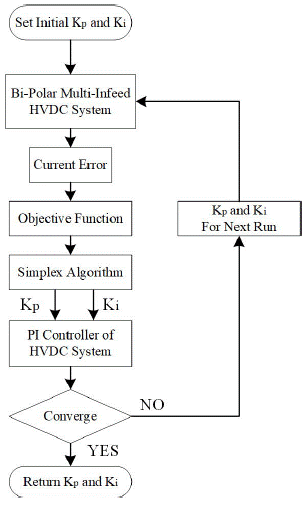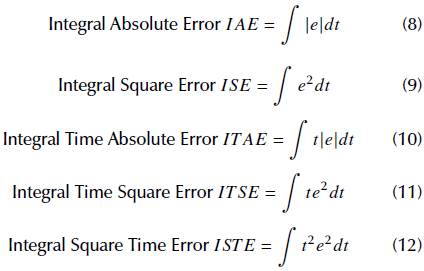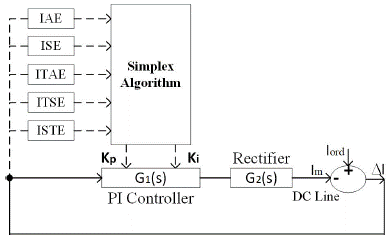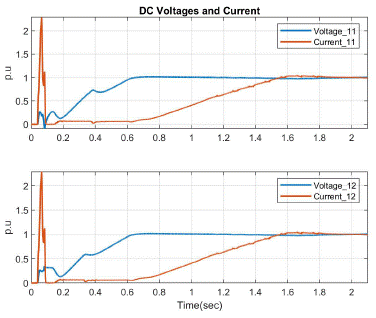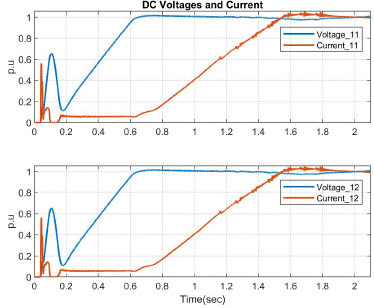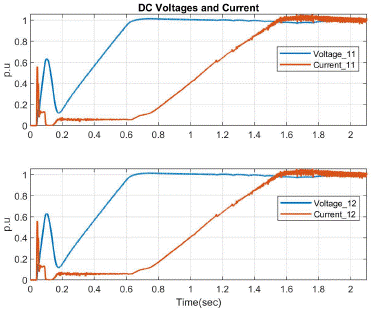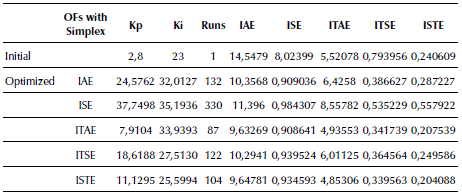Introduction
The AC/DC system stability is a significant performance evaluator of HVDC systems (Anbarasi and Muralidharan, 2016). The performance of a system relies on its stability and dynamic performance. The efficiency of a control system is estimated by exposing the system to fault or disturbance and observing its reaction under these abnormal conditions (Tan et al., 2006). The HVDC control system based on line commutation converters is influenced by the number ofbfactors (Sellick and Åkerberg, 2012), but the PI controller is considered the most influential control among all. The overall system stability depends on it because the response of the current controller is directly affected by the PI controller (Jing et al., 2002).
Tuning has always been essential for controllers. Control engineers are very serious to make the system more robust, so constructing a proper tuning algorithm for control parameters is in vogue (Srinivas et al., 2014; Yang et al., 2006). Previously, engineers used Ziegler Nichols method for tuning purposes (Ho et al.e, 1995; Ziegler and Nichols, 1993), but now researchers make their efforts to adopt a fast and efficient technique of tuning. Therefore, modification in procedures are shifting toward the soft computing method. There are a lot of soft computing techniques used to tune the gains and time constant of the PI or PID controller (Stojic et al., 2017). Some examples are simplex algorithm (Gole et al., 2003; Zhao et al., 2007), linear programing based tuning (Oliveira et al., 2014), Modified Genetic Algorithm (Y. P. Wang et al., 2002), offline tuning of discrete-time fractional-order to minimize the cost function (Merrikh-Bayat et al., 2015), Hybrid PID-Artificial Neural Network (ANN) controller to control PWM signal for DC to DC conversion (Muruganandam and Madheswaran, 2013), fuzzy logic algorithm (Sahin and Altas, 2017; Ilyas et al., 2013; Kassem, 2013), State Transition Algorithm (STA) (Saravanakumar et al., 2015), Particle Swarm Optimization (PSO) (Aazim et al., 2017; Rajagopal and Ponnusamy, 2014), etc. With the help of these techniques, it became easy to select parameters intelligently and give optimal results in a very short time compared with the arbitrary or logarithmic searches. Offline tuning methods have also been considered to calculate cost functions by solving the equations (Merrikh-Bayat et al., 2015; M. Wang et al., 2016) or linear models (Oliveira et al., 2014), which is proficient but too complicated.
In this paper, the technique consists in constructing current error in a simulation for the objective function, instead of solving equations and designing a system model or transfer function through system identification (Eriksson, 2011) using MATLAB (Ho et al., 1995; Xu, 2013). This technique is fine, but it is difficult with lack of perfections and does not give precise and flawless results compared with the system. Optimizations are based on time simulation of a HVDC system (Filizadeh and Gole, 2005; Gole et al., 2005). The simulation gives accurate results. Further convergence of the fitness value appearing from every objective function (Jing et al., 2002; Saravanakumar et al., 2015) is performed through simplex algorithm in PSCAD (Zhao et al., 2007). This control design optimization methodology can also be applicable in future HVDC projects in Colombia, which has a rating of 2 000 MW/500 kV DC and project of Colombia-Panama, which has a rating of 400 MW/300 kV DC. It is expected to be in operation in 2025.
Stability issues of this system have also been resolved by simulated self-generated (SSG) PSO (Aazim et al., 2017), but the question arose for the selection of compatible OF with PSO in the process of research and implementation. For this purpose, ISE-OF was selected after survey. The team agreed on a single point and concluded it might be possible that another OF can behave well. In this paper, SG-SA has been used for the optimal selection of PI control parameters for multiple controllers of a HVDC system, and of the best suitable objective functions among all on the basis of the logged data results through a comparison chart. The design process of this method is difficult, but its operation is easy and produces precise control parameters. However, for this kind of optimization process, the resources and time required for computing are considerably higher.
Optimization techniques
In this technique, the optimized PI control parameters are obtained through time simulation results of a system. PSCAD-based simulation makes the HVDC system robust through PI control parameters. It is done after the evaluation of the best objective function for the simplex algorithm. Five different types of objective functions (Filizadeh et al., 2007; Saravanakumar et al., 2015) are taken intoaccount to optimize the initial PI control parameters of a bipolar HVDC system.
Simplex Algorithm
The nonlinear-simplex method was introduced by Nelder and Mead for heuristic optimization (Grešovnik, 2007; Rana et al., 2016), which is based on geometric consideration. Vertices of simplex are set of the n + 1 point and geometric object is formed in a set of n-dimensional space. An algorithm is initiated by initial simplex parameters x 1 (1),... . x (1) n+1 with n + 1 vertices. The function at vertices is estimated after the generation of the initial parameter. Points are moved steadily in a single iteration according to a strategy that makes the function minimum (Gole et al., 2003).
The simplex algorithm minimizes the fitness value by generating the new vertices through order, reflection, expansion, contraction, shrink and finally, convergence status checked in multiple iterations.
An algorithm is formed as follows:
Choose the initial simplex parameters and then evaluate the function in its vertices.
The number of iterations is obtained in terms of k.
In ordering, the vertices are recorded and their functions are the following:
Reflection is the worst vertex reflected between the superlative n vertices center point
Reflected point x r k are calculated as follows:
If condition
 is satisfied, take x
r
k
and move toward the convergence check.
is satisfied, take x
r
k
and move toward the convergence check.
Expansion takes place if
 , then, calculate x
e
k
, then, calculate x
e
k
If condition
 is satisfied, then take x
e
k
, otherwise, take x
r
k
and move toward the convergence check.
is satisfied, then take x
e
k
, otherwise, take x
r
k
and move toward the convergence check.
Outside and inside contraction is performed if

If
 , it is named as outside contraction, then, calculate
, it is named as outside contraction, then, calculate

If expression
 is satisfied, then, take x
k
c
and move toward the convergence check.
is satisfied, then, take x
k
c
and move toward the convergence check.
If
 , it is named as inside contraction, thus find x
k
c
, it is named as inside contraction, thus find x
k
c
If expression
 is satisfied, then, take x
k
c
and move toward the convergence check.
is satisfied, then, take x
k
c
and move toward the convergence check.
Shrink pass all vertices except the best one.
Then, evaluate function
 and take V
i
k
as fresh vertices.
and take V
i
k
as fresh vertices.
If convergence is satisfied, then, the iterations end, otherwise initiate the next iteration.
This process repeats again and again with a number of iterations to reduce the fitness value of the function sluggishly until it reaches in the optimum point vicinity.
The simplex algorithm is one of the convergence algorithms to obtain optimized control values, in order to produce the smallest fitness value of an objective function through a soft computing optimization technique. This technique is used in this work to get the optimal values of multiple PI (Aazim et al., 2017) controller parameters (Saravanakumar et al., 2015). Several runs are executed to minimize the fitness value of an objective function (Filizadeh and Gole, 2005), as shown in Figure 1.
In the simulation, the previously defined PI control parameters, k p and ki, of a system are set as the initial values to the simplex algorithm, and the tolerance is set to 0,0001.
The selection of control parameters of a system is a very sensitive task to make the system dynamically stable and robust (Muruganandam and Madheswaran, 2013). In case of simplex algorithm, it is essential to set the initial control parameters, because upcoming runs depend on them. Usually, the previous control parameters are deliberated as initial value (Jing et al., 2002).
The first step is to set the initial control parameters of the HVDC bipolar system and to generate a current error, which is sent to the objective function to integrate the whole error effect and obtain the fitness value. This process evaluates the best objective function through multiple runs of simulation for selecting optimal control parameters by using a simplex algorithm (Gole et al., 2003; Zhao et al., 2007).
The pre-arranged procedure can improve overshoot, rise time and settling time of response. In the case of the HVDC inverter and rectifier, current error is considered, because little variation in current can affect the whole network. Our main focus is to stabilize the current that in turn improves the system.
Objective function
This paper describes the idea for the selection of an objective function in the simulation environment. By using this idea, the objective function of a problem can be designed easily in simulation programming. Five objective functions (IAE, ITAE, ISE, ITSE, and ISTE) are compared for tuning purposes. These objective functions are individually used to find the fitness value that is further fed into simplex algorithm to obtain optimization parameters of multiple PI controllers. The difference of reference current (Iord) and measured current (Im) is error current (CERRR) (Aazim et al., 2017; Saravanakumar et al., 2015).
CERRR is calculated in the simulation environment of PSCAD. Error current for the aforementioned objective functions is shown in Figure 2. The fitness value is found by taking current error from simulation of the HVDC system and forwarding it to the objective functions. It can be handled effortlessly for the selection of optimum gains (k p and k i ) of PI controllers. Their results would be more precise than the offline tuning technique. Through this technique it is not essential to solve an equation or computing transfer function for the construction of current error as in the conventional approach.
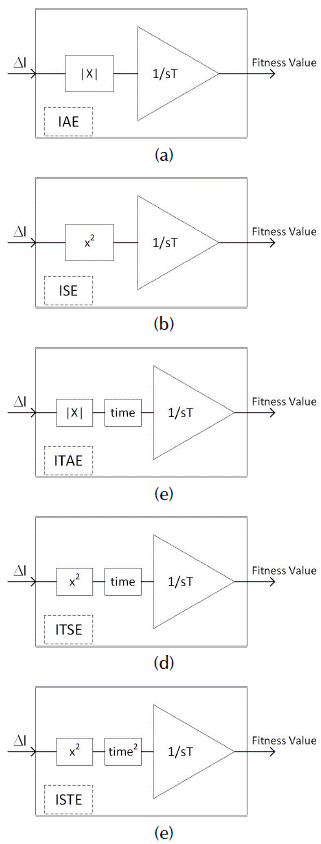
Source: Aazim et al. (2017)
Figure 2 Block Diagram of objective functions: (a) IAE, (b) ISE, (c) ITAE, (d) ITSE, and (e) ISTE.
These five different types of objective functions designed in a simulation environment of PSCAD are used with simplex algorithm.
The five objective functions are the following:
The fitness value of these functions is converged through simplex algorithm to attain the stability in a system by PI control parameters.
The convergence graphs of objective functions are shown in Figure 3. It can be concluded from graphs that the fitness value is reducing in all cases. It is observed that some objective functions attain tolerance range in a smaller number of simulation runs, whereas others attain it in a larger number of simulation runs.
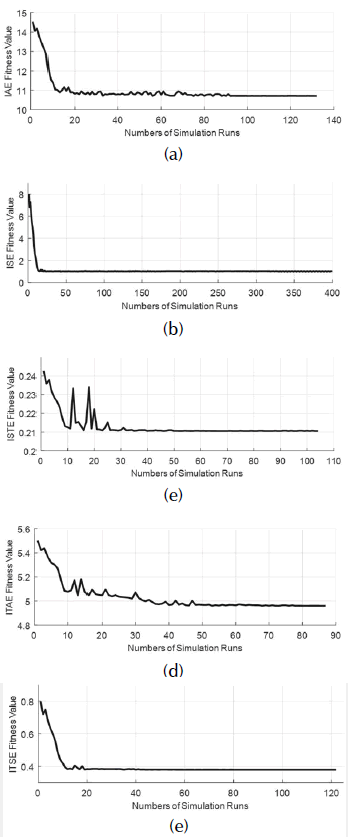
Source: Authors
Figure 3 Convergence graphs of simulation-based objective function using simplex algorithm: (a) IAE, (b) ISE, (c) ITAE, (d) ITSE, and (e) ISTE.
Tuning of control parameters through the simplex algorithm in time simulation route is represented by a dotted line in Figure 4. Each objective function (IAE, ISE, ITAE, ITSE, and ISTE) operates individually. The simplex algorithm generates new parameters in each run of simulation by considering the fitness value of the objective function.
HVDC network under consideration
The model of multi-infeed HVDC systems interconnecting Central and East China power systems is shown in Figure 5 and it is used as a test network. PI control parameters are optimized for one of three lines, i.e. three Gorges-Changzhou ± 500 KV HVDC (Jing et al., 2002). These optimized control parameters are also implemented in other two HVDC lines. The results are produced after multi-runs of the optimization process and presented in graphs and tables.
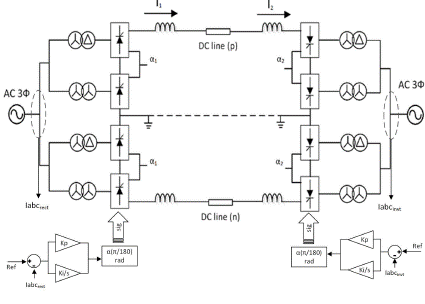
Source: Authors
Figure 5 Bipolar Connection of HVDC transmission line with closed-loop control. Source: Jing et al. (2002).
Three 940 Km long HVDC lines of rated voltage ± 500 KV are interconnected with the help of bipolar configuration, as shown in Figure 6. Power capacities of the three lines are 3 000 MW, 3 000 MW and 1 200 MW for line-1, line-2 and line-3, respectively. Line with 3 000 MW HVDC capacity comprises the upper and lower side of the bipolar system 2 x 1500 MW (Jing et al., 2002).
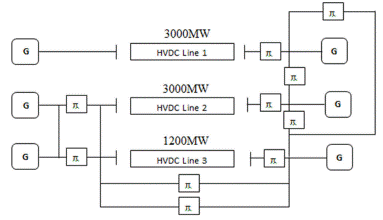
Source: Jing et al. (2002)
Figure 6 Three HVDC lines connecting Central China and Eastern China power system.
The simulation of HVDC contains AC-DC (Rectifier) and DC-AC (Inverter), as shown in Figure 5. The AOI-11, 12 and AOR-11, 12 are the firing angles of the bipolar inverter and rectifier. The rectifier is considered for the active and reactive power of the system under examination.
This is the closed-loop control system of HVDC, and the PI controllers are used for controlling power in the operation of conversion. Two independent PI controllers are used to control the firing pulse of the upper and lower bridge of the converter. The input of the controller is the current error, whereas the output is the firing angle of thyristor bridge. Block diagram of closed-loop control is shown in Figure 4 and Figure 5. However, the Kp and Ki have a huge contribution to online optimization. Algorithmic based automatic tuning of the aforementioned gains of PI controller is presented in this paper.
The procedure applies to divide the tasks into two cases, i.e. Case I and Case II for finding optimized parameters of PI controllers. Case I shows the system performance on all control parameters related to objective functions. Case II describes the disturbance analysis of control functions related to the best selected objective functions.
CASE-I
The initial parameters of the existing PI controller of San-Chang network of multi-infeed HVDC systems are k p = 2,8 and k i = 23 for both rectifier and inverter sides.
To implement the optimization technique, previous values of control parameters are used as initial parameters in the simplex algorithm. The initialization of the simplex algorithm for optimization through these parameters can reduce the overshoots, undershoots, rise time and settling time with the help of the fitness value of an objective function. Plots of first polar and second polar DC voltages and DC currents of bipolar configuration of HVDC are voltage_11, voltage_12, current_11 and current_12, as shown in Figure 7.
Tuning Through IAE, ISE and ITSE Objective Function
IAE, ISE and ITSE with simplex produces the proportional and integral gains of 24,576228 and 32,012679 in 132 runs with IAE, 37,749841 and 35,193554 in 330 runs with ISE, and 11,129470 and 25,599420 in 104 runs of simulation with ITSE. With these control parameters, voltage and current graphs are compared with initial gains. Graphs are shown in Figure 7 and 8. Starting overshoot in DC voltages and current at both poles of the HVDC system has improved but unstable behavior of the system was observed from 0,2 to 0,6 sec and after 1,4 sec in the response of current. This is shown in Figure 8a, whose zoom portion of upper side is in Figure 8b. In these figures, performance trends with these objective functions are nearly same.
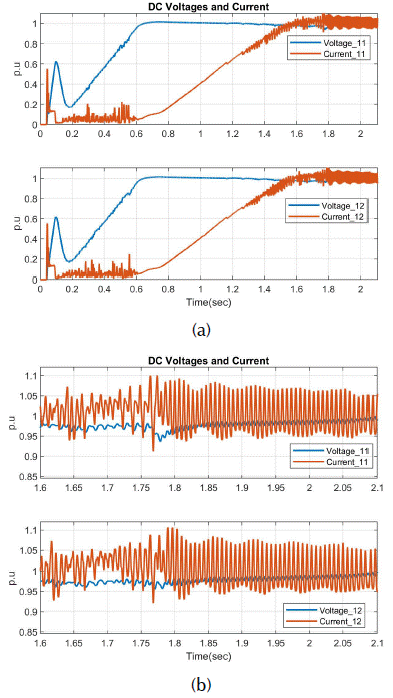
Source: Authors
Figure 8 DC voltage and current waveforms with (a) IAE, ISE and ITSE parameters and (b) zoomed portion of upper Figure 8a.
Tuning Through ITAE Objective Function
ITAE with simplex produces the proportional and integral gains (k p and k i ) of 7,910455 and 33,939345 after 87 multiple runs of simulation. Using these control parameters, voltage and current graphs are compared with the initial gain graphs shown in Figure 7 and Figure 9. With these parameters, the system generates stable results and starting overshoot in DC voltages and current at both poles of the HVDC system has improved.
Plots of the first polar and second polar DC voltages and DC currents of a bipolar configuration of HVDC are voltage_11, voltage_12, current_11 and current_12, as shown in Figure 9.
Tuning Through ISTE Objective Function
The simplex algorithm produces the proportional and integral gains (k p and k i ) of 11,129470 and 25,599420 in 104 runs of simulation with ISTE. Using these control parameters, voltage and current graphs are compared with initial gains. Graphs are shown in Figure 7 and 10. With these parameters, the system generates stable results similar to those of ITAE parameters.
case-ii
Table 1 and plots shown in the above figures indicate that the objective function ITAE seems to be the best among all. Disturbance analysis of multi-infeed HVDC system is required to study the performance of ITAE control parameters. Case-2 illustrates the system performance. The procedure is applied to insert three phases to ground fault at the rectifier side of the second line in time simulation for a finite interval of 0,04 sec, i.e. from 2,6 to 2,64 sec. Figure 11,12,13 and 14 show the PSCAD simulation results of the three lines active-reactive power comparison between initial and optimized control parameters of HVDC. The legend shown in figures of active_1, 2, 3 and reactive_1, 2, 3 are the active-reactive powers of the HVDC line-1, line-2 and line-3.
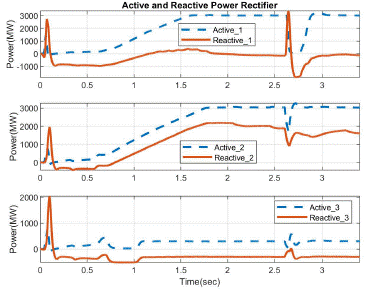
Source: Authors
Figure 11 Active-reactive power three-line waveforms HVDC Rectifier with initial parameters.
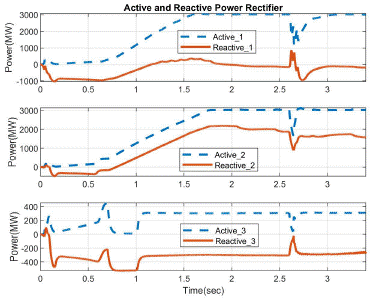
Source: Authors
Figure 12 Active-reactive power three-line waveforms of HVDC Rectifier with ITAE parameters.
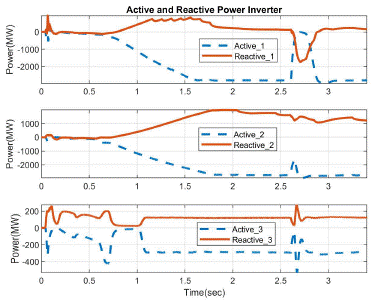
Source: Authors
Figure 13 Active-reactive power three-line waveforms of HVDC Inverter with initial parameters.
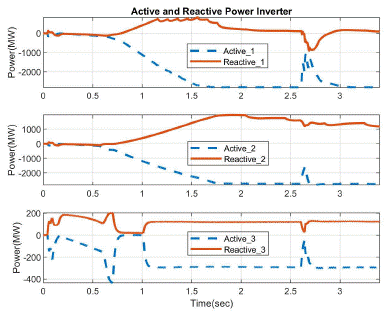
Source: Authors
Figure 14 Active-reactive power three-line waveforms of HVDC Inverter with ITAE parameters.
Results collected after using optimized control parameters are shown in Figure 13 and 14.
Simulation Results
Enhancements in the system parameters are shown in Table 1 and Table 2. Two cases are considered in this paper. Case-1 describes results of different types of objective functions and their control parameters and case-2 describes results of the best objective function and their control parameters in a situation of disturbance. The objective function has two purposes. One purpose is the optimization of parameters with simplex algorithm and the other purpose is judgment of the system robustness through the minimum value of the objective function. In Table 1, vertical objective functions merged with simplex algorithm and their control parameters are obtained after a number of simulation runs. The horizontal objective functions and their minimum value clarify the system robustness. The horizontal objective function and their numerical values in Table 1 are achieved by setting 2,1 sec simulation run time for no disturbance. Table 2 shows the result of control parameters of the best compatible objective function ITAE from simplex algorithm. Horizontal objective function numerical values in Table 2 are obtained by setting a 3,7 sec simulation run time for disturbance from 2,6 to 2,64 sec. It is observed that optimized control parameters improved settling time, overshoot, numerical value of objective function and variation in power drop with or without fault condition. This shows the robustness of the system.
Conclusion
In this paper, time simulation design of multi-infeed HVDC bipolar configuration is presented. Primarily, multiple PI controllers of the HVDC system are considered and it was concluded that the system can be robust by tuning their control parameters. Five objective functions (IAE, ISE, ITAE, ITSE and ISTE) are used with SG-SA in PSCAD software, and their results are compared with each other using values of voltage, current and active-reactive power for rectifier and inverter. It is observed that ITAE is the best option with SA tuner because it gives the best overall responses than other OFs in minimum runs of 87. Finally, their results are matched with initial control parameters results. In all cases, responses like overshoot-undershoot, rise time and settling time are improved, but some issues were observed at the end of current response with objective functions of IAE, ISE and ITSE. This indicates the unstable behavior of the system due to fast asymmetric variations of these functions. ITAE-OF with SA tuner produced robust and optimized responses. Finally, it is suggested that all objective functions with soft computing techniques (SA or PSO) can be used for tuning purposes of controller, but selection of one OF is necessary. When comparing the optimized results of active-reactive powers of SSG-PSO (Aazim et al., 2017) and SG-SA parameters, responses of ISE-PSO are slightly better than ITAE-SA. From all these performances of system, it might be possible that PSO with ITAE-OF can produce surprising results.
























